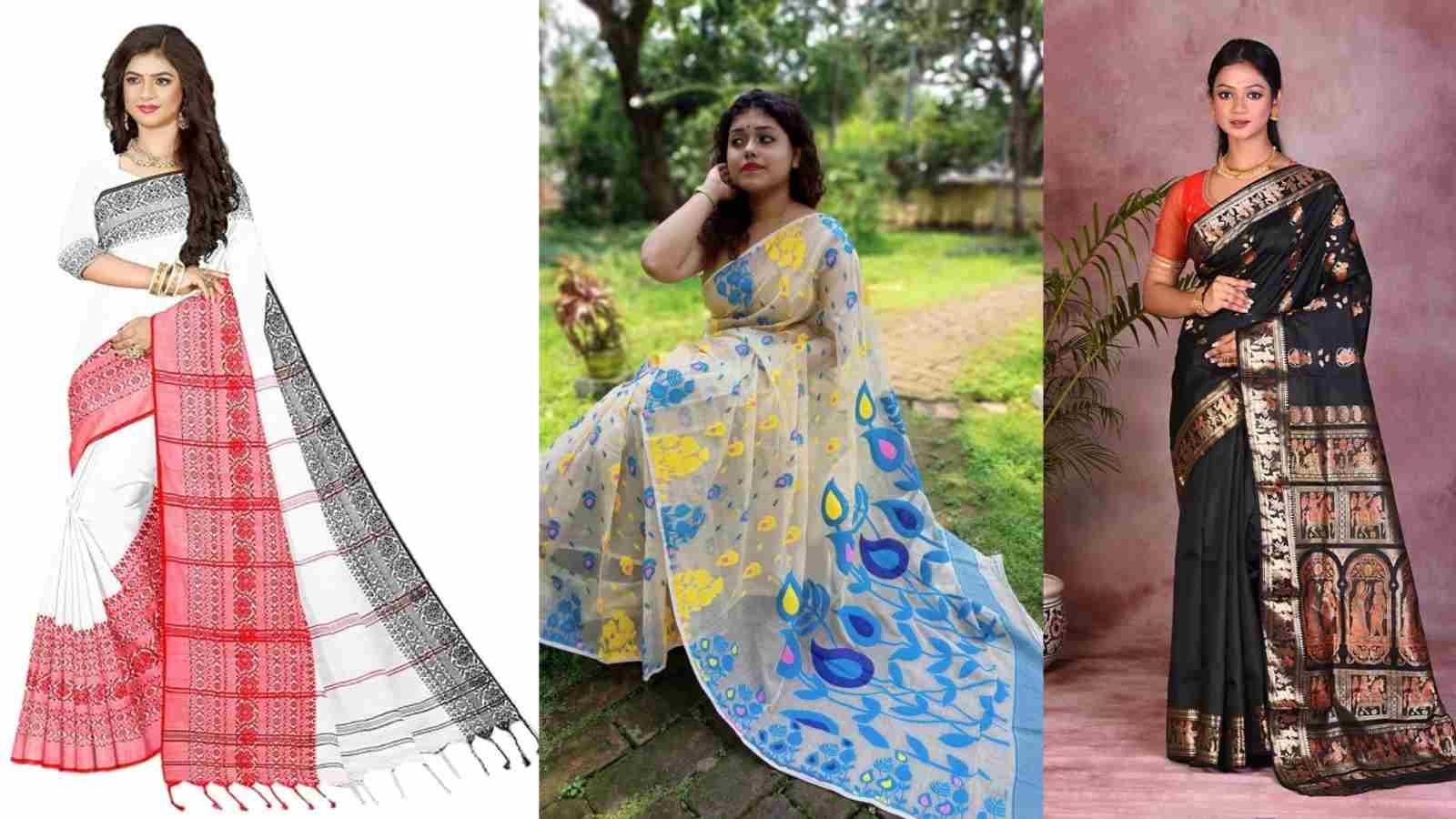Bengal boasts a diverse and rich tradition of handloom sarees, known for their craftsmanship and cultural significance. Bengal handloom sarees are renowned for their exquisite craftsmanship, intricate designs, and rich cultural heritage, particularly their use of traditional motifs and the lightweight, breathable fabric. They are a blend of artistry, comfort, and a connection to the region’s history, making them a timeless addition to any wardrobe.
These sarees are produced by skilled weavers who employ traditional methods passed down through generations, ensuring each saree is unique and carries the essence of Bengal’s weaving heritage.
On National Handloom Day, let’s take a look into a few popular varieties of handloom sarees of Bengal.
Tant handloom sarees
Famed for their ease and simplicity, these cotton sarees are a must-have for every Bengali woman’s closet. They have a light, airy feel, vibrant colours, and simple patterns. Tant sarees are deeply intertwined with Bengali culture and are worn during festivals like Durga Puja, weddings, and other significant occasions. As a handwoven product made from natural fibers, Tant sarees are a perfect example of sustainable fashion.
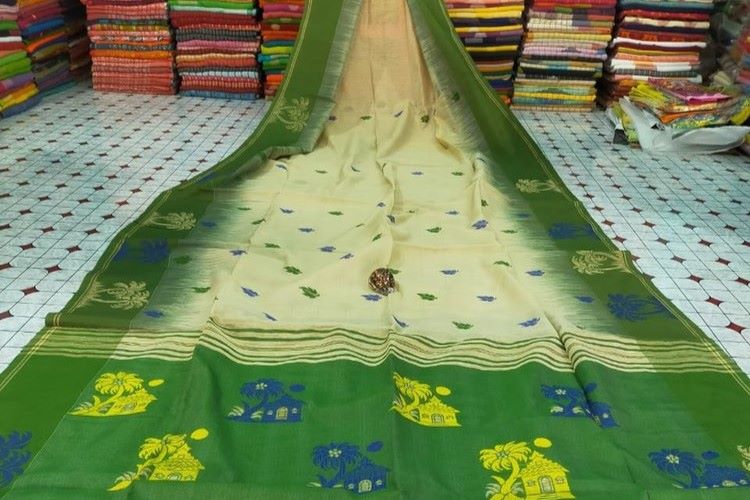
Tant sarees are traditionally made from cotton, making them lightweight and breathable, which is perfectly suited for the region’s warm and humid climate.
Tant sarees are distinctive for their elaborate borders and pallus and feature a variety of intricately woven motifs, often inspired by nature and daily life, such as florals, paisleys (kalka), geometric shapes, and traditional symbols. Some popular traditional motifs include Tabeej (amulet), Bhomra (bumble bee), Rajmahal (royal palace), Ardha-chandra (half moon), Chandmala (garland of moons), Kalka/buta (paisley) and Phool (flowers).
These sarees are produced in Fulia and Shantipur of Bengal’s Nadia district, Dhaniakhali, Hooghly district, Begampur, Hooghly district, and Kalna, Burdwan district.
These are traditionally woven on handlooms, often involving a meticulous and time-consuming process. The yarn is prepared by washing, bleaching, dyeing, and starching the cotton threads to enhance their fineness and strength. The designs are drawn by artists and transcribed onto perforated cardboards, which are then suspended from the loom to guide the weaving.
While traditionally handwoven, power looms are also increasingly being used to meet market demand and incorporate modern techniques.
Dhaniakhali sarees
Dhaniakhali sarees are handloom sarees originating from Dhaniakhali region of West Bengal’s Hooghly district. These sarees are crafted using traditional handloom techniques, specifically on a bamboo reed, which controls the threads during weaving. These sarees are traditionally woven on a shuttle-pit loom or a fly-shuttle loom, using age-old techniques.
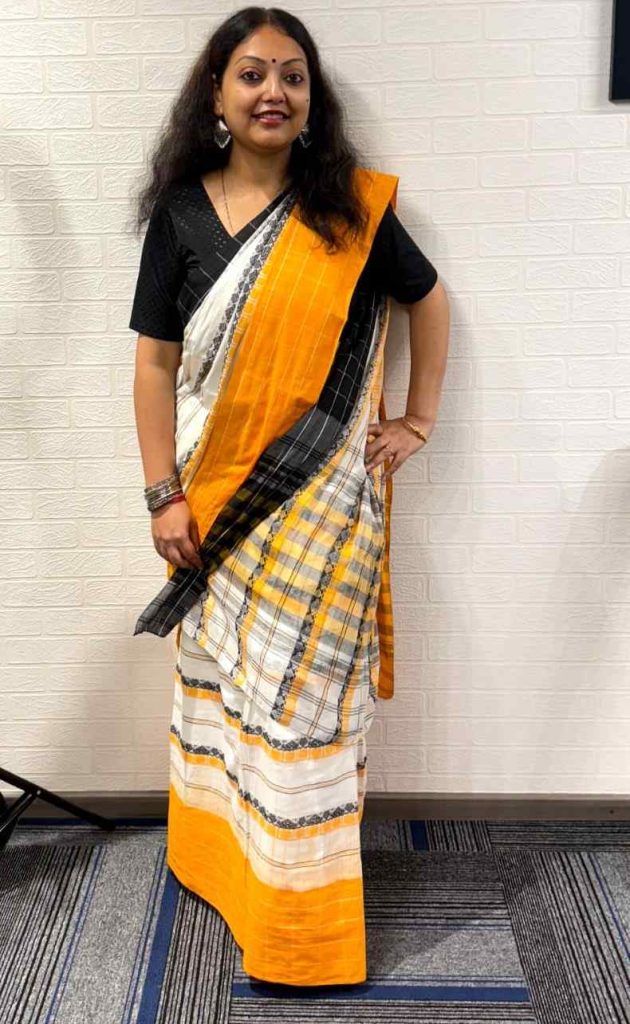
Dhaniakhali sarees are typically made from cotton, and their distinctive feature is the compact weave and colourful borders, often 1.5 to 2 feet wide. They are primarily made from pure cotton, specifically 100/100 cotton thread count, making them lightweight and comfortable.
The sarees are a significant part of West Bengal’s textile tradition, with the name “Dhaniakhali” directly linked to the place where these sarees are woven.
Dhaniakhali sarees have been granted a Geographical Indication (GI) tag, recognizing their unique origin and traditional craftsmanship. This tag signifies that the sarees are produced using traditional methods and possess qualities specific to their geographical origin.
Begumpuri sarees
Begumpuri sarees are a testament to West Bengal’s rich handloom tradition, originating from the town of Begumpur in Hooghly district of West Bengal. These sarees are known for their lightweight, breathable cotton fabric and distinctive weaving style, often featuring contrasting borders and serrated patterns on the pallu.
Begumpuri sarees are known for their distinctive borders. They often feature bold, contrasting borders woven with colourful threads or zari (golden thread). These sarees feature traditional motifs which include geometric shapes, floral designs, and paisley prints.
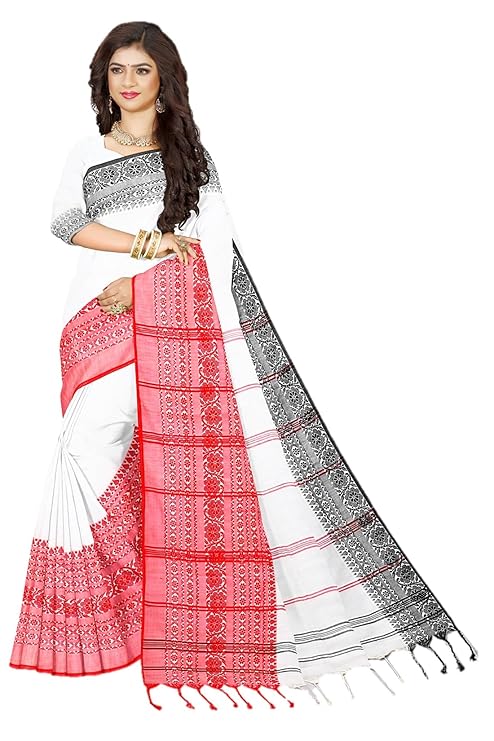
Weavers use traditional pit looms or frame looms to create these sarees, a technique passed down through generations.
The weaving traditions of Begumpur date back to the Mughal era, when these sarees were primarily crafted for local aristocracy. The weaving tradition is over 250 years old and has been passed down through generations, making it a symbol of the region’s heritage.
An application for a Geographical Indications (GI) tag for “Begampur Cotton Handloom Saree” is currently under examination. Obtaining a GI tag would help protect the intellectual property rights associated with this traditional craft.
Baluchari sarees
Originating in the town of Baluchar (currently Jiaganj-Azimganj) in Murshidabad district around the 18th century, the tradition later shifted to Bishnupur in Bankura district after a flood destroyed the original weaving centre.
Traditionally, Balucharis were woven using the ‘jala’ technique, a hand-weaving method that allowed for reversible motifs. However, this technique has largely been replaced by Jacquard looms.
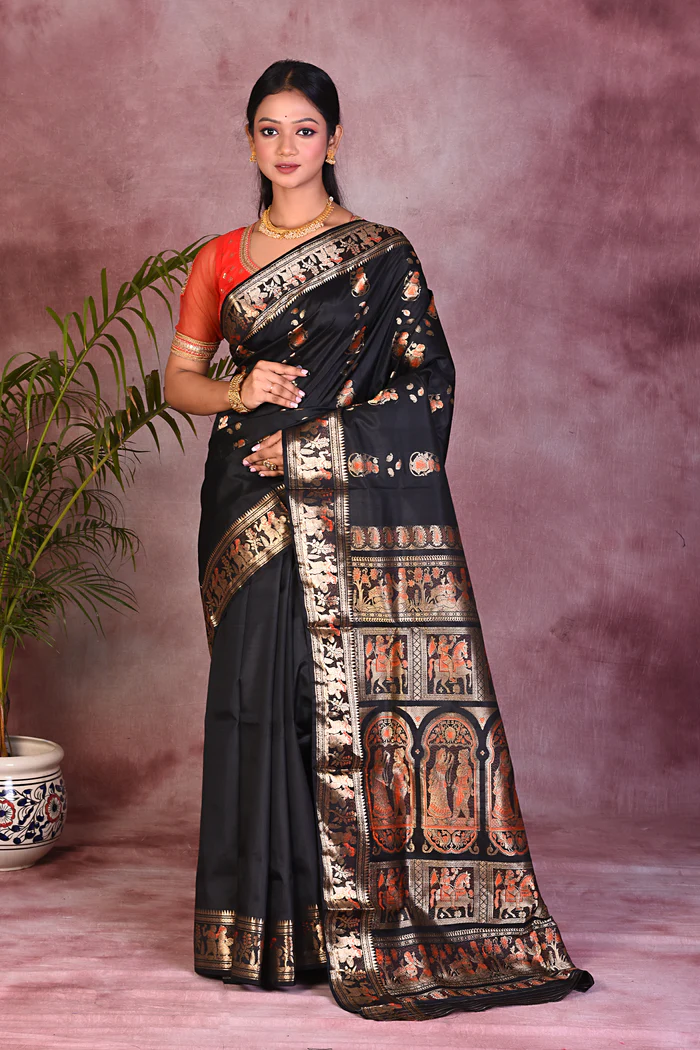
Authentic Balucharis are woven from pure mulberry silk from Murshidabad. This dense and luxurious fabric gives the sarees a beautiful drape and feel. Balucharis come in vibrant and festive colours like red, green, white, blue, and yellow. Black, brown, and maroon are also used in modern adaptations. Originally, they were made with silver zari, which has been replaced by different coloured threads.
The most striking feature of a Baluchari saree is the arrangement of the designs on the pallu (the decorative end piece) and the borders. These often depict stories and characters from Hindu epics like the Ramayana and Mahabharata, as well as scenes from ancient court life or folklore. Common motifs include women dancing, animals, plants, women riding chariots, and scenes like Krishna explaining the Bhagavad Gita to Arjuna.
Garad sarees
Garad sarees are elegant handwoven silk saree originating from the Murshidabad district of West Bengal, India. The name “Garad” itself means “white” in Bengali, highlighting the saree’s distinctive pure white or off-white base. Garad sarees are known for being lightweight, making them easy to drape and comfortable to wear.
The white colour of the Garad saree symbolizes purity, holding deep significance in Bengali rituals and traditions. Garad sarees are widely worn during religious ceremonies, festivals, and other auspicious events. These sarees hold particular significance during the Bengali festival of Durga Puja. Wearing a Garad saree is customary during the Sindoor Khela ceremony, a vibrant ritual performed on the final day of Durga Puja.
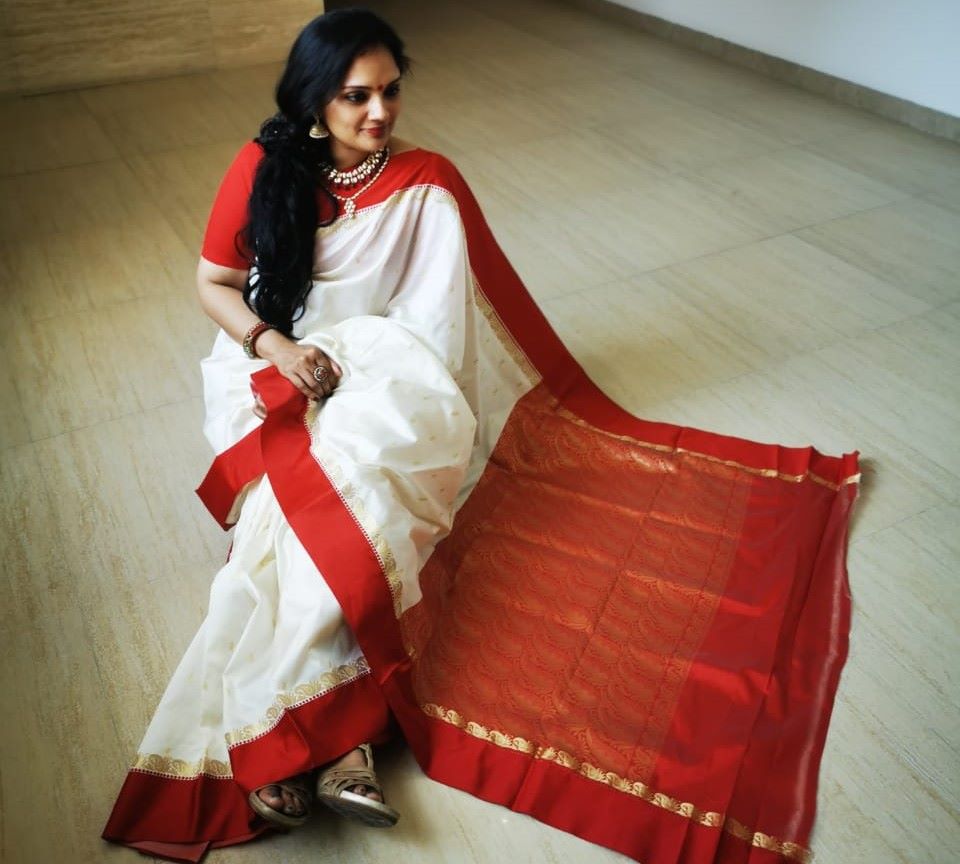
Primarily crafted from fine quality mulberry silk, or sometimes tussar silk. The silk yarns are not dyed, preserving the fabric’s natural colour and enhancing its purity. The sarees typically feature a pure white or off-white body, often accompanied by red or maroon borders and pallu (the decorative end piece). This colour combination, particularly the red and white, carries symbolic importance.
Garad sarees are known for their understated elegance. They generally feature simple yet intricate designs, often including stripes, small paisley motifs, or floral patterns. The silk yarns are woven close together, resulting in a fine, smooth texture. The weave can be described as resembling crisp tissue paper.
Dhakai Jamdani sarees
Any discussion on handloom sarees is incomplete without mentioning Dhakai Jamdani sarees. Renowned for their intricate handloom artistry, lightweight texture, muslin-like softness, and exquisite motifs, these sarees have their origin in Dhaka, Bangladesh. The weaving technique has been perfected by generations of skilled Bengali artisans.
The term “Jamdani” is believed to be of Persian origin, with “jam” meaning flower and “dani” meaning vase, reflecting the prevalence of floral motifs. Dhakai Jamdani weaving can be traced back to the Mughal era when it was considered a luxury fabric for the nobility.
Initially, Jamdani motifs were inspired by nature and were geometric in shape, created by weavers counting threads.
After the partition of Bengal in 1947, many weavers migrated to West Bengal, India, where the craft continues to flourish alongside Bangladesh.
Dhakai Jamdanis are handloom woven, making them a time and labour-intensive craft. The weaving process involves a supplementary weft technique to create intricate designs directly onto the loom, often on a fine cotton or silk base.
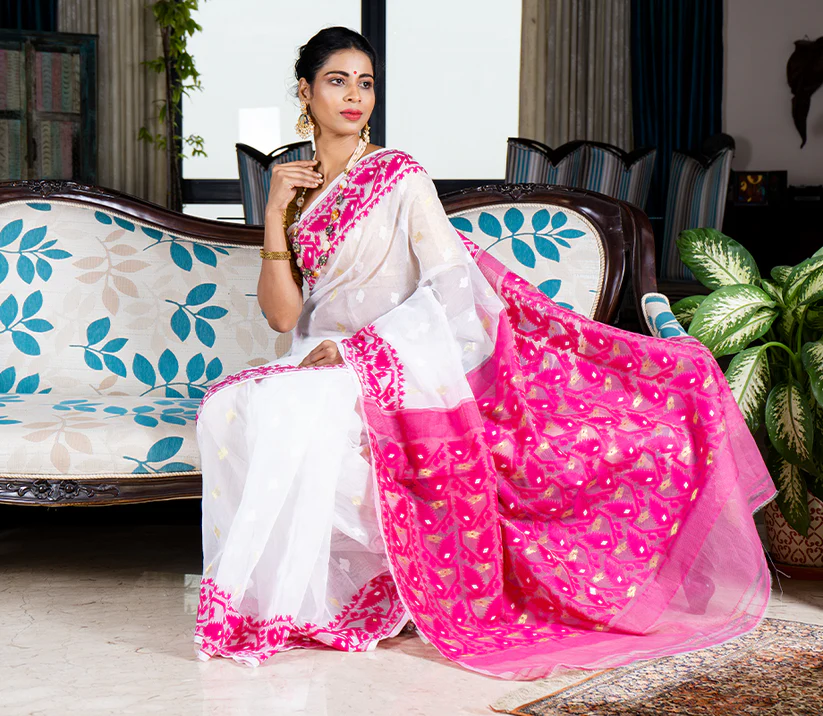
The fabric is known for its sheer quality, lightweight, and breathability, making it ideal for warmer climates. Traditional Jamdanis feature designs woven into muslin fabric, often in grey and white, or using cotton and gold threads.
Dhakai Jamdanis are known for their intricate motifs including floral, geometric, figurative, and abstract designs. Motifs often draw inspiration from nature, mythology, and daily life, carrying cultural significance. Popular motifs include Panna Hajar (A thousand emeralds), Kalka/buta (Paisley), Butidar (Small flowers), Fulwar (Flowers arranged in straight rows), Terchha (Diagonal patterns), Jhalor (Motifs evenly covering the entire saree), Duria (Polka dots) and Charkona or rectangular motifs.
Long or Short, get news the way you like. No ads. No redirections. Download Newspin and Stay Alert, The CSR Journal Mobile app, for fast, crisp, clean updates!
App Store – https://apps.apple.com/in/app/newspin/id6746449540
Google Play Store – https://play.google.com/store/apps/details?id=com.inventifweb.newspin&pcampaignid=web_share

